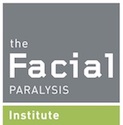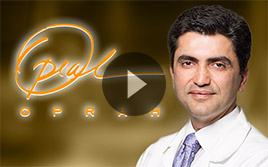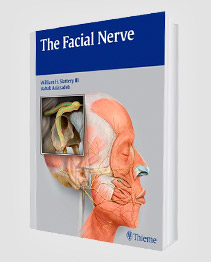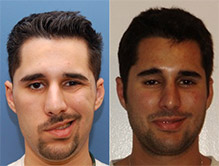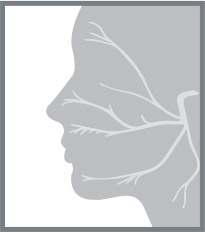Synkinesis refers to simultaneous facial movement that happens after a patient experiences Bell’s palsy. Or, synkinesis can occur after a patient undergoes a surgical procedure in which the facial nerve was previously cut and reconnected. In this instance, facial nerve wires can be linked to the incorrect nerve group, leading to unwanted facial muscle movement patterns.
Neuromuscular retraining, also referred to as physical therapy, is one of the most common treatments to correct linked facial movements, facial coordination issues, and other synkinesis symptoms. A physical therapy program is tailored to a patient’s symptoms, and it requires hard work and patience from both the patient and their physical therapist.
What Is Neuromuscular Retraining for Synkinesis?
Facial neuromuscular retraining can be used to rehabilitate facial musculature in patients dealing with synkinesis or other types of facial paralysis. It involves the use of facial neuromuscular retraining exercises tailored to a patient. Over time, these exercises can help a patient regain the ability to produce natural facial expressions. They can also alleviate facial paralysis symptoms.
Research Highlights the Impact of Neuromuscular Retraining for Synkinesis
To date, multiple studies have been performed that highlight effectiveness of neuromuscular retraining for facial paralysis. In one study, researchers explored the use of facial neuromuscular retraining for brow to treat oral and ocular to oral synkinesis in patients coping with facial nerve disorders. They found that most patients who used facial neuromuscular retraining exercises reduced their synkinesis.
In another study, researchers looked at the effectiveness of physical therapy for facial paralysis combined with electromyography. The study involved patients coping with synkinesis, Ramsay Hunt syndrome, and other forms of facial palsy. Study researchers determined physical therapy and electromyography together helped facial palsy patients reduce their symptoms. Furthermore, synkinesis patients in the study reduced their symptoms by two levels.
Facial neuromuscular retraining research is ongoing. Meanwhile, many options are available for patients exploring options for treatment of facial paralysis symptoms.
For patients considering neuromuscular retraining for facial paralysis, consulting with a facial palsy expert like Dr. Babak Azizzadeh of The Facial Paralysis Institute is crucial. Dr. Azizzadeh can evaluate his patient’s symptoms and determine if neuromuscular retraining can be used to treat them.
Dr. Azizzadeh and his team want neuromuscular retraining to be a rewarding experience for synkinesis patients. Before a patient begins physical therapy, Dr. Azizzadeh and his team develop a custom therapy plan. They then work with a patient to execute this plan and help him or her strengthen their facial muscles and improve facial muscle coordination and movement patterns.
How Can I Tell If I’m Dealing with Synkinesis?
Synkinesis comes in the form of any abnormal and simultaneous facial muscle movements. It can cause a variety of symptoms, including:
- Twitching in the chin, cheeks, and other areas of the face
- Cheek creases that can make the paralyzed side of the face appear bulky
- Facial muscle tightness that causes pain and/or headaches
- Narrowing of the eyes when an individual smiles
- Lifting of the cheek when an individual closes their eyes
The symptoms of synkinesis can appear minor at first. If left unaddressed, however, these symptoms can escalate quickly. They can lead to severe facial paralysis that causes long-lasting damage to a person’s facial appearance, too.
At the first sign of facial paralysis symptoms, consult with a doctor. Then, an individual can receive a medical evaluation, followed by an appropriate treatment.
If facial paralysis symptoms for many months following an initial treatment, consult with Dr. Azizzadeh. From here, Dr. Azizzadeh can find out if the symptoms are caused by synkinesis or another form of facial palsy. Dr. Azizzadeh can then decide if surgery or another treatment option can be used to alleviate these symptoms. And, he can determine if physical therapy can be beneficial.
When Does Neuromuscular Retraining for Synkinesis Start?
There is no set period when every synkinesis patient should begin neuromuscular retraining. Since each physical therapy program is tailored to a patient, the right time to begin varies.
Approximately 85% of patients coping with Bell’s palsy, shingles, and other conditions that can cause facial palsy fully recover within about three months of treatment. Yet, if a patient continues to experience facial paralysis symptoms many months after treatment, physical therapy can be beneficial.
By meeting with Dr. Azizzadeh, a patient can undergo a comprehensive evaluation. A surgical procedure or other treatment options may be recommended depending on the patient, followed by neuromuscular retraining.
If Dr. Azizzadeh finds that physical therapy can be beneficial for a patient, he can develop a personalized therapy plan. This plan is implemented at a time deemed to be safe for a patient and can help him or her manage their facial palsy symptoms.
What Exercises Are Included in a Facial Neuromuscular Retraining Program?
Facial neuromuscular retraining exercises vary. To determine which exercises should be incorporated into a physical therapy plan, Dr. Azizzadeh considers any surgical procedures that a patient can receive to treat synkinesis and other forms of facial palsy. In doing so, Dr. Azizzadeh can help patients use physical therapy exercises to enhance the function of various facial movement patterns and muscles. They can also ensure these patients are better equipped than ever before to produce natural facial expressions going forward.
If a patient undergoes a facial nerve transfer procedure, the nerve can overcorrect itself. When this occurs, a patient can experience hyper-contractions in the facial muscles after surgery.
For facial nerve transfer patients, a combination of stretching and massage exercises can be integrated into their physical therapy program. These exercises can help facial nerve transfer patients reduce facial tissue tightness, as well as learn how to use the proper muscles to smile, frown, and make other facial expressions.
In instances where the facial nerve is damaged during tumor removal surgery, the nerve heals at a rate of about 1 inch per month. Following tumor removal, a patient may regain the ability to move the mouth upward and show other signs of recovery within about 10 to 12 months of surgery. At this point, a patient can begin a therapy program to gradually strengthen their facial nerve.
If a patient is coping with Bell’s palsy that does not disappear on its own within about three months of onset, neuromuscular retraining can be used to strengthen affected facial muscles and improve muscle movement patterns. During a retraining program, a Bell’s palsy patient can learn which muscles to use to make different facial expressions.
How Often Are Neuromuscular Retraining for Synkinesis Sessions Required for Facial Rehabilitation?
The frequency of neuromuscular retraining sessions depends on the patient, the severity of their facial paralysis symptoms, and other factors. By partnering with Dr. Azizzadeh, a patient can find out how often sessions are required, along with how to maximize the effectiveness of their physical therapy exercises.
At the Facial Paralysis Institute, a synkinesis patient initially meets with occupational therapist Jackie Diels for neuromuscular retraining. Diels can teach the patient physical therapy exercises in our office. She can also respond to any concerns or questions regarding these exercises and ensure the patient knows how to perform them properly.
Once a patient learns how to correctly perform retraining exercises and feels comfortable and confident with them, he or she can continue their physical therapy program at home. The patient must stay on track with their physical therapy program to achieve the best results.
Over the course of a retraining program, a patient’s results are monitored by Dr. Azizzadeh. Patients are also encouraged to reach out to the Facial Paralysis Institute if they have concerns or questions at any point during their program.
Is Neuromuscular Retraining for Synkinesis Painful?
Synkinesis can cause pain, but neuromuscular retraining is used to help patients reduce or eliminate this issue. Thanks to physical therapy, a patient can use exercises to strengthen facial muscles affected by synkinesis. As a patient performs these exercises, pain may decline accordingly.
If a patient experiences pain during their program for neuromuscular retraining for synkinesis, notify Dr. Azizzadeh immediately. This enables a patient to receive expert support from Dr. Azizzadeh and limit the risk of potential treatment complications.
Is Neuromuscular Retraining for Facial Paralysis Safe and Effective?
The benefits of neuromuscular retraining can be significant, particularly for synkinesis patients. By exploring physical therapy with Dr. Azizzadeh, a patient can determine if physical therapy is the best option to manage their symptoms.
Dr. Azizzadeh is world-renowned for his facial plastic and reconstructive surgery and head and neck surgery expertise, and he wants to help patients alleviate their facial paralysis symptoms. Although Dr. Azizzadeh may recommend surgery to help patients address synkinesis, physical therapy can be beneficial for patients in the months after treatment.
A consultation with Dr. Azizzadeh can be valuable for a patient. At this time, Dr. Azizzadeh learns about a patient and their symptoms and crafts a custom treatment plan. Dr. Azizzadeh can also explain if he believes physical therapy can be beneficial to help a patient manage their symptoms.
If Dr. Azizzadeh believes physical therapy is a safe, effective option to help a patient address their symptoms, he works with his team to determine which exercises should be incorporated into a neuromuscular retraining program. Finally, with this plan in place, a patient can get the necessary help to achieve long-term symptomatic relief.
Is Neuromuscular Retraining the Best Option for Treatment of Facial Paralysis?
Facial retraining can be beneficial for patients dealing with synkinesis or other types of facial palsy. Retraining can help these patients improve abnormal facial muscle movement patterns. It can be combined with other facial palsy treatment options as well.
Can Facial Neuromuscular Training Be Used in Conjunction with Electrical Stimulation to Treat Synkinesis?
Facial palsy patients may explore electrical stimulation to treat their symptoms. Electrical stimulation involves the use of electrical pulses to mimic impulses that give the facial muscles their tone and shape. It can be beneficial in patients dealing with complete loss of the facial nerve. In other patients, electrical stimulation can inadvertently cause the facial muscles to become overstimulated. If this occurs, the treatment can lead to synkinesis.
Is Neuromuscular Retraining for Facial Rehabilitation Right for You?
Physical therapy can help facial palsy patients regain the ability to produce natural facial expressions and/or improve their verbal and non-verbal communication. But, it is one of several treatments that patients can use to address their facial palsy symptoms.
In some instances, physical therapy can be used following surgery for facial paralysis. Or, it can be leveraged in conjunction with Botox injections. Regardless, it is paramount that any facial paralysis treatment is customized to the patient.
Dr. Azizzadeh can provide a facial palsy patient with a personalized treatment plan. He conducts a medical evaluation and myriad tests to assess his patient and their symptoms. Dr. Azizzadeh may then recommend surgical or non-surgical treatment for facial paralysis. He may recommend physical therapy as well.
Schedule a Synkinesis Treatment Consultation with Dr. Azizzadeh
Patients who are coping with synkinesis can meet with Dr. Azizzadeh to explore a wide range of treatment options. To learn more or to schedule an in-person or virtual treatment consultation with Dr. Azizzadeh, please contact us online or call us today at (310) 657-2203.
Request your consultation with Dr. Azizzadeh today
Call us at (310) 657-2203 to schedule an appointment.
Schedule a Consultation